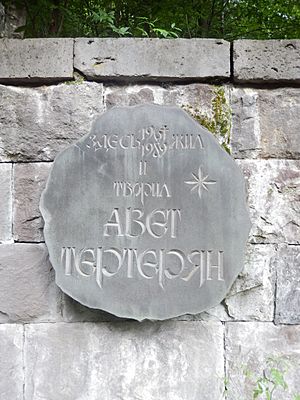Avet Terterian facts for kids
Quick facts for kids
Avet Terterian
PAU
|
|
|---|---|
| Born | July 29, 1929 |
| Died | December 11, 1994 (aged 65) Yekaterinburg, Russia
|
| Nationality | Armenian |
| Known for | Composer |
Alfred Roubenovich "Avet" Terterian (born July 29, 1929 – died December 11, 1994) was an Armenian composer. He was known for his powerful and unique musical style. He even won the Konrad Adenauer Prize for his work.
Terterian created eight complete symphonies, which are like big musical stories played by an orchestra. He also wrote an opera, which is a play set to music, and several chamber works for smaller groups of instruments.
Avet Terterian was good friends with other famous composers like Giya Kancheli, Konstantin Orbelyan, and Tigran Mansurian. Even the very famous composer Dmitri Shostakovich praised Terterian. Shostakovich called him "very talented" and said he had a "great future." He heard Terterian's music at a summer resort in Dilijan, Armenia.
Contents
Who was Avet Terterian?
Avet Terterian was a highly respected composer from Armenia. His music often explored deep feelings and used unique sounds. He blended traditional Armenian music with modern styles.
His Early Life and Studies
Avet Terterian began his music studies in 1948 at the Music Academy in Baku. Later, in 1951, he moved to the Romanos-Melikian Music Academy. He then studied how to compose music at the Komitas State Conservatory in Yerevan starting in 1952.
He took on important roles early in his career. From 1960 to 1963, he was the Executive Secretary of the Armenian Composers’ Union. He also led the Music Department at the Armenian Cultural Ministry from 1970 to 1974. In 1985, he became a professor at the Yerevan Conservatory. Later, in 1989, he moved to a village called Ayrivank, near Lake Sevan in Armenia.
His Amazing Musical Creations
Avet Terterian wrote many different kinds of music. He is especially famous for his symphonies and his opera. His works often have a strong emotional impact.
Symphonies and Operas
Terterian composed eight complete symphonies. These are large-scale musical pieces for an orchestra. Each symphony tells a story or explores a theme through music. Some of his symphonies even include traditional Armenian instruments like the duduk and zurna.
He also wrote an opera called "Ring of Fire" in 1967. An opera is a big musical play where characters sing their lines. In 1979, he created a ballet called "Monologues of Richard III." A ballet is a story told through dance and music.
Here are some of his notable works:
- 1967 — "Ring of Fire." An opera in two acts.
- 1969 — First Symphony.
- 1972 — Second Symphony.
- 1975 — Third Symphony. This one uses traditional Armenian instruments like the duduk and zurna.
- 1976 — Fourth Symphony.
- 1978 — Fifth Symphony. This symphony includes the kyamancha and large bells.
- 1979 — "Monologues of Richard III." A ballet.
- 1981 — Sixth Symphony.
- 1984 — "Earthquake." An opera.
- 1987 — Seventh Symphony.
- 1989 — Eighth Symphony.
- 1991 — String Quartets №2.
- 1994 — Ninth Symphony (he didn't finish this one).
Music for Movies
Avet Terterian also composed music for films. His music helped to make these movies more powerful and memorable.
- 1973 — "Chronicle of Yerevan Days."
- 1985 — "The rider, who was expected."
His music was also used in many other films, even if he didn't compose the whole soundtrack. Some examples include:
- 1988 — "Our Armored Train"
- 1991 — "Vox Clamantis in Deserto"
- 1994 — "The Last Station"
- 2010 — "To Ararat"
As an Actor
Interestingly, Avet Terterian also appeared as an actor in one film:
- 1991 — "Dzayn barbaro ..."
His Legacy and Influence
The city of Yekaterinburg in Russia holds an annual music festival named after Terterian. This shows how much his music is still admired.
His friend, Giya Kancheli, wrote a special musical piece called "Styx." It was a farewell to Terterian and another composer, Alfred Schnittke. The choir in the piece even sings their names.
Terterian's son, Dr. Ruben Terterian, was also involved in music. He was a professor in Ecuador and a former leader at the Komitas State Conservatory of Yerevan. One of Avet Terterian's most famous students was Vache Sharafyan, who also became a well-known composer.
Literature
- Terteryan R. Conversations with Avet Terteryan – Moscow – Ekaterinburg : Armchair Scientist, 2015


